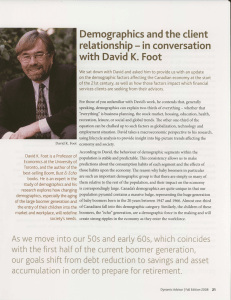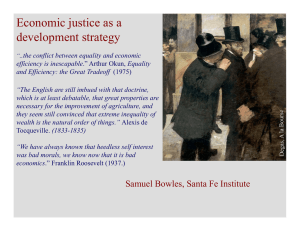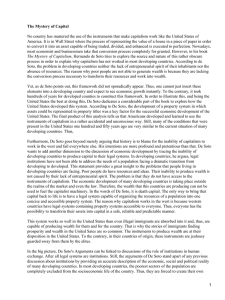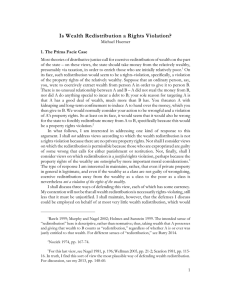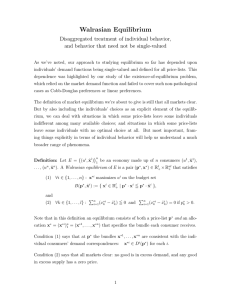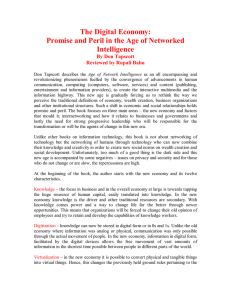Bequests, Taxation and the Distribution of Income and Wealth
Anuncio
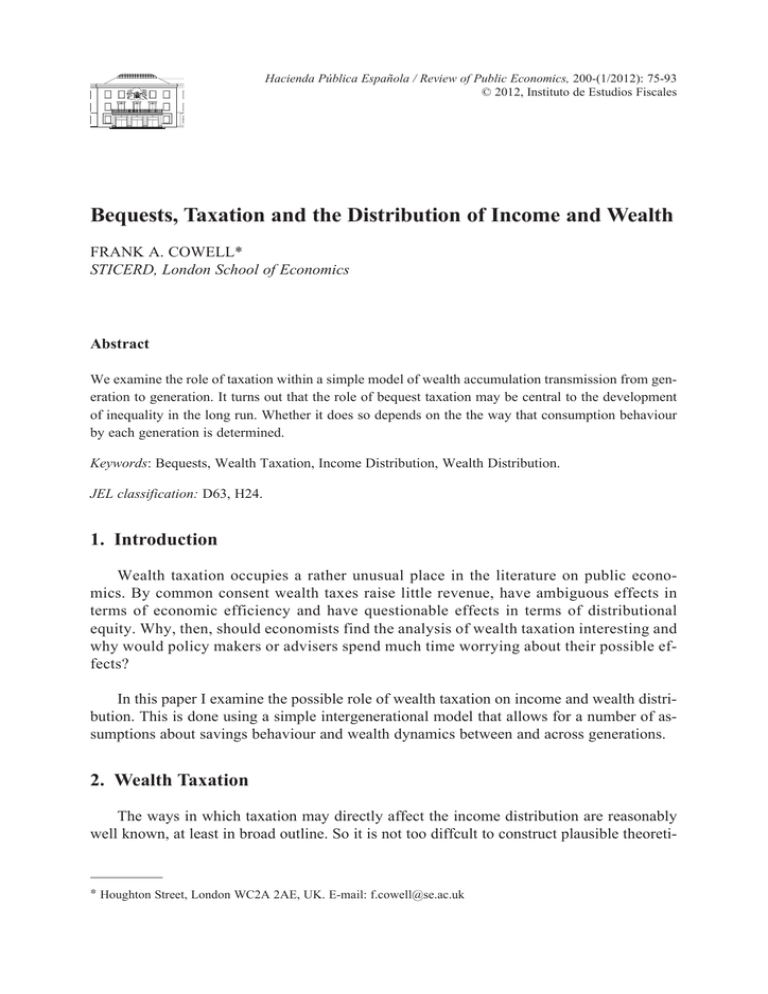
Hacienda Pública Española / Review of Public Economics, 200-(1/2012): 75-93 © 2012, Instituto de Estudios Fiscales Bequests, Taxation and the Distribution of Income and Wealth FRANK A. COWELL* STICERD, London School of Economics Abstract We examine the role of taxation within a simple model of wealth accumulation transmission from gen­ eration to generation. It turns out that the role of bequest taxation may be central to the development of inequality in the long run. Whether it does so depends on the the way that consumption behaviour by each generation is determined. Keywords: Bequests, Wealth Taxation, Income Distribution, Wealth Distribution. JEL classification: D63, H24. 1. Introduction Wealth taxation occupies a rather unusual place in the literature on public econo­ mics. By common consent wealth taxes raise little revenue, have ambiguous effects in terms of economic efficiency and have questionable effects in terms of distributional equity. Why, then, should economists find the analysis of wealth taxation interesting and why would policy makers or advisers spend much time worrying about their possible ef­ fects? In this paper I examine the possible role of wealth taxation on income and wealth distri­ bution. This is done using a simple intergenerational model that allows for a number of as­ sumptions about savings behaviour and wealth dynamics between and across generations. 2. Wealth Taxation The ways in which taxation may directly affect the income distribution are reasonably well known, at least in broad outline. So it is not too diffcult to construct plausible theoreti­ ∗ Houghton Street, London WC2A 2AE, UK. E-mail: [email protected] 76 FRANK A. COWELL cal models of, say, the influence that the individual income tax has on the distribution of la­ bour-market earnings and, in view of the abundance of rich data sets, to produce plausible empirical estimates of the model parameters, even though opinions will obviously differ with respect to the precise details of model specification and the political or economic desirabi­ lity of any particular income-tax structure. But the situation is rather different in the case of wealth taxation. Why do we even have wealth taxes? It is a subject that arouses passion in policy discussions. Some of the propo­ nents of wealth taxation argue that it is a fundamental tool for establishing and maintaining distributional fairness. Some of the opponents of wealth taxation take the position that it is an unwarranted erosion of personal freedom and a manifestation of the politics of envy; some go further and assert that not only is wealth taxation politically objectionable it is also economically irrelevant. It is on this latter claim that we shall focus in this paper. Obviously wealth taxes must have some effect on the distribution of wealth and therefore an indirect ef­ fect also on income distribution. But the processes are not understood as well as the direct links between taxes and income distribution. 2.1. Forms of wealth taxation It is conventional to distinguish between taxes on the stock of wealth and those related to the transfer of wealth between individuals. If we were to stretch a point we could also bring into consideration other types of taxes, such as capital gains tax or conventional income taxes, that clearly have an impact on the accumulation of wealth. We shall focus pri­ marily on the taxation of wealth transfers that sometimes goes under the name of estate taxes, death duties, inheritance taxes or bequest taxes 1. At key points of the argument we shall compare their effects with those of annual wealth taxes, one-off wealth levies and income taxes. 2.2. Importance of wealth taxation A crude answer to the question of how important wealth taxes are is to look at the ex­ tent to which governments rely on them. How much revenue is raised through wealth taxation? Tables 1 to 3 show the amount raised by wealth taxation as a proportion of total tax revenue for seven OECD countries and three different definitions of wealth taxes 2. Even on the broadest definition (Table 1) the proportion raised is modest –hardly ever exceeding 15 percent for any country in any year. However this definition includes local taxes on physical property (particularly important for countries such as the UK) that are intended for funding local government rather than being part of some sort of overall national distributional objective. If we strip these out then the picture is as in Table 2. If we remove 77 Bequests, Taxation and the Distribution of Income and Wealth from consideration all annual wealth taxes and further restrict attention just to taxes on the transfer of wealth then we have the situation depicted in table 3. Table 1 ALL PROPERTY TAXES AS A PERCENTAGE OF TOTAL REVENUE Canada France Germany Spain Sweden UK US 1965 1975 1985 1990 1995 2000 2005 2007 2008 2009 14.27 4.29 5.81 6.36 1.78 14.54 15.88 9.47 5.14 3.86 6.31 1.11 12.71 13.95 9.33 5.77 3.02 5.94 2.34 11.97 10.66 10.02 6.32 3.37 5.52 3.52 8.17 11.45 10.66 6.65 2.77 5.51 2.71 10.03 11.08 9.52 6.86 2.28 6.43 3.42 11.59 10.10 10.06 7.73 2.47 8.59 2.96 12.08 11.25 10.32 7.92 2.50 8.09 2.45 12.55 11.17 10.57 7.68 2.36 6.95 2.33 11.65 12.09 11.11 8.05 2.30 6.45 2.37 12.23 13.69 Table 2 WEALTH AND WEALTH TRANSFER TAXES AS A PERCENTAGE OF TOTAL REVENUE Canada France Germany Spain Sweden UK US 1965 1975 1985 1990 1995 2000 2005 2007 2008 2009 2.32 2.32 4.36 5.92 1.75 3.32 2.16 1.05 1.93 2.73 5.93 1.10 1.94 1.55 1.23 2.27 1.96 3.71 1.45 1.56 0.97 1.75 2.91 2.39 4.09 2.34 1.52 1.00 1.65 2.19 1.75 3.55 0.93 1.35 0.98 1.77 2.60 1.13 4.52 1.42 2.98 1.22 1.93 2.96 1.15 6.66 1.11 2.92 0.89 1.85 3.07 1.27 6.25 0.70 3.66 0.82 1.65 2.73 1.16 4.79 0.71 2.47 0.91 1.45 2.40 1.06 3.89 0.62 1.99 0.76 Table 3 WEALTH TRANSFER TAXES AS A PERCENTAGE OF TOTAL REVENUE Canada France Germany Spain Sweden UK US 1965 1975 1985 1990 1995 2000 2005 2007 2008 2009 1.46 0.56 0.22 1.09 0.39 2.62 2.06 0.27 0.75 0.14 0.79 0.25 0.82 1.45 0.03 0.61 0.22 0.41 0.26 0.69 0.82 0.00 0.95 0.34 0.42 0.19 0.65 1.00 0.00 0.82 0.26 0.51 0.16 0.58 0.98 0.00 1.07 0.39 0.63 0.22 0.62 1.22 0.00 1.19 0.53 0.74 0.08 0.70 0.89 0.00 1.08 0.48 0.73 0.00 0.76 0.82 0.00 0.93 0.53 0.79 0.00 0.63 0.91 0.00 0.93 0.51 0.80 0.00 0.50 0.76 Whatever definition we use of wealth taxes they clearly do not raise large amounts of revenue for contemporaneous redistribution. In particular the quantitative importance of bequest taxation appears very small indeed –even in Spain and France it is less than 1 per­ cent of total revenue– and we might wonder whether this means that in one respect the op­ ponents of wealth taxes are correct: for practical purposes such taxes could seem comple­ tely negligible. However, this paper will argue that even apparently quite small taxes can have a surprisingly large effect on the wealth distribution and hence on the income distri­ bution. 78 FRANK A. COWELL 3. Model The literature contains a great diversity of types of model for analysing the dynamics of we­ alth distribution and the processes involved in the transfer of wealth. They range from compli­ cated general treatments incorporating a wide variety of components, to those of beguiling sim­ plicity that pick out just one or two elements of the bequest-dynamic process; the former often require numerical simulation in order to yield specific results and may not be ideally suited to clear policy insights; the latter may give clear-cut results but at the cost of accepting overly strong assumptions about economic mechanisms. For the present purpose we need the type of model that allows one to capture the different forms of taxation within the same framework. To do this we can use an approach based on that outlined originally in Champernowne and Cowell (1998). 3.1. Individuals and dynasties We imagine society to consist of a large number of dynasties that persist throughout his­ tory. Within each dynasty there will be a sequence of generations, each of the same length. More than one generation will be alive at the same time, but each dynasty is represented by exactly one wealth holder at any given moment in history, as will be explained in a moment. The nature of the dynasties enables us to tell a simple story of wealth accumulation wi­ thin generations and wealth transfer between generations. We abstract from issues of marria­ ge and fertility. The reason for this is to be able to focus clearly on the unfolding story of sa­ vings and wealth accumulation within and between generations. How taxes affect families and how family dynamics affect the bequest process and the distribution of income and we­ alth are obviously important topics, but they require separate treatment 3. Each generation is represented by one person who is then replaced by exactly one successor: clearly we could extend the model by assuming two persons in each generation of each dynasty with some ap­ propriate assumption about marriage patterns and equal bequests to their two children, but that would not greatly add to the insights from the analysis. 3.2. Time As with many models of wealth accumulation and bequest taxation there are two aspects of time: time elapsed within any one generation and the sequence of generations. The age of a person is denoted by a continuous variable θ; the generations are indexed by n which can take integer values only. This is not a true overlapping-generations model –we do not at­ tempt to capture general equilibrium aspects 4– but the interlocking nature of the generations does have a role to play within our framework, as follows. In any generation n the representative person lives for a period of length 2θ̄ in which there are three important life events. The person (1) becomes an independent adult (worker) at age θ = −θ̄ , (2) inherits at age θ = 0 and, (3) passes on a bequest at age θ = θ̄ . Only the interval [−θ̄ , θ̄ ] 79 Bequests, Taxation and the Distribution of Income and Wealth is economically interesting within the context of the model. The connections between the gene­ rations can then be illustrated as in Figure 1. The generations are represented by the sequence of horizontal bars and the three life events are represented by the three blobs on each bar. n–1 – – 0 –θ θ Bn–1 – tax n – – 0 –θ n+1 θ – Bn 0 –θ n+2 – –θ – θ 0 – θ Figure 1. Time line for generations Within this time frame we may discuss the principal economic components of the be­ quest story – resources (Subsection 3.3) and individual behaviour (Subsection 3.4). 3.3. Resources and income In each generation a person’s income y(θ ) at time θ ∈ [−θ̄ , θ̄ ] consists of two parts, ex­ ogenous income (earnings) e(θ ) and interest income rW(θ ), y(θ ) = e(θ ) + rW(θ ) (1) where r is the interest rate and W(θ ) is the current stock of wealth 5. Wealth comes from in­ heritance and previous saving during the life-cycle –see equation (5) below– so, before in­ heriting (at θ = 0) income consists of exogenous income only. Obviously a person’s exogenous income e(θ ) is in practice likely to vary with θ; but this phenomenon is not very interesting for the purposes of our discussion. Accordingly we will assume that each person’s exogenous income is fixed at ē; we will discuss a relaxation of this assumption below. 3.4. Behaviour A key feature of any bequest model is what drives consumption within each generation. To address the issue we need to be clear about three things: the appropriate representation of 80 FRANK A. COWELL preferences for consumption over one’s lifetime and the consumption by one’s successors, the characterisation of rational behaviour, the specification of market conditions. 3.4.1. Preferences As far as preferences affecting consumption over a person’s lifetime are concerned we can adopt a version of the standard lifecycle model possibly adapted to allow for responses to uncertainty 6: the precise specification of this part of the story will turn out to be unimpor­ tant for the core of the analysis that follows. However, the specification of preferences over the allocation between consumption by one’s own generation and consumption by subse­ quent generations presents a greater challenge. In the literature there is a wide variety of models of bequest motive 7 ranging from, in the most sophisticated versions, a kind of infi­ nite-horizon altruism, through versions involving a limited next-generation altruism or “warm glow“ motivation, to very simple versions of “accidental bequest”. 3.4.2. Rationality In the context of decision making within an atemporal framework or within a time frame that is strictly limited within an individual’s lifetime the issues concerning rational decision are comparatively straightforward. It makes sense to consider optimisation by individuals subject to a determinate budget constraint. But, when we are dealing with inter-generational decision-making, the issues inevitably become more complicated. We could attempt to trans­ pose the limited-horizon paradigm to this broader context as, for example, in Becker and Tomes (1979). But this transposition raises some awkward questions: who is/are the deci­ sion maker(s)? How are conflicts of interest between generations to be resolved? 8 How far is it reasonable to assume foresight on the part of the rational decision makers? 3.4.3. The market Again the transposition from simple optimisation models over a short horizon to decision­ making over generations presents some difficulty. Which resources should be assumed to be on the right-hand side of the budget constraint –just those owned and controlled by generation n, or should those of the next generation (such as expected earnings of sons and daughters) also be included? Should we assume that individuals everywhere have access to perfect credit markets? In the approach below consumption is determined in one of the following ways: • Target life style. We assume that individuals pursue a given life style subject to an income constraint: c(θ ) = min {c–, y(θ )} (2) Bequests, Taxation and the Distribution of Income and Wealth 81 for all θ ∈ [−θ̄ , θ̄ ], where c– is the target life style or “consumption aspirations” of each person such that – c– > e (3) and y(θ) is given by (1) 9. Bequests are “accidental.” This is the principal model, de­ veloped in Section 4. • Adaptive consumption behaviour. This is similar to the target life-style model, but consumption plans adjust in the light of unfolding information about resources and life style is “inherited” from the previous generation –see Subsection 6.1. • Intergenerational optimisation. In each generation the representative individual maximises a simple utility function under conditions of almost perfect foresight. This is analysed in Subsection 6.2. In each case our focus is principally on the relationship between the assumed consump­ tion behaviour and the resulting equilibrium distribution of wealth and income and how wealth taxation affects this relationship. 3.5. Tax Taxation enters the wealth-accumulation and income- and wealth-distribution story at a number of points. If we imagine this story as one of two principal chapters –the intragener­ ational part and the intergenerational part– then the more interesting of the two is clearly the intergenerational “chapter”. So the role of income tax or even an annual wealth tax, will be less interesting as much of the impact would be in the intragenerational chapter; as we will see the key role here is played by bequest (or inheritance) taxation 10. We will assume the following simple tax schedule on bequests B: max {τ[B − W*], 0} (4) where W* is an exemption level and τ is the constant marginal tax rate on bequests in excess of the exemption level. Without much difficulty the tax schedule (4) could be modifed in principle to take account of “asset-based egalitarianism” concerns by incorporating start-of­ life grants also; the tax schedule would then resemble a negative income tax. 4. Dynastic Behaviour, Equilibrium and Distribution 4.1. Within lifetime As explained in Subsection 3.2, in each generation a person’s lifetime falls into two parts characterised by diferent economic circumstances and behaviour. In the first part, during the 82 FRANK A. COWELL interval [−θ̄ , θ̄ ], the person with consumption behaviour given by (2) and (3) consumes just as much as he earns. In the second half of the person’s life, he has access to inherited wealth as well as exogenous income. Given the stated consumption behaviour and the inherited wealth W(0) (from the previous generation’s bequest after tax) we can find the wealth at any point in the second half of the person’s life θ ∈ [0, θ̄ ]: W(θ) = max {W(0)erθ − B* [erθ − 1], 0}, (5) where B* = c −e r (6) is the discounted gap between consumption aspirations and exogenous income. Roughly speaking that gap is filled by consuming inherited wealth wherever possible. So, wealth rises/declines during the second half of the person’s lifetime according as W(0) ; B*. We will see that this has important implications for intergenerational dynamics. 4.2. Between generations Under the assumption of accidental bequests, whatever the stock of wealth happens to be at age θ̄ is what is to be bequeathed to the next generation. So, at the end of the person’s life the following bequest is made Bn = W(θ̄ ). (7) However, the inheritance received by a person in the next generation will depend on the bequest / inheritance tax in place –see the representation in Figure 1. Taking the tax system (4) the initial wealth for generation n + 1 must be W(0) = min {Bn, [1 − τ]Bn + τW*}. (8) –see Figure 2. Now use equation (5) to obtain the expression for wealth at the end of a person’s life in any generation W(θ̄ ). From (7) and (8) we can compute Bn+1, the bequest made by a person in generation n + 1, as a function of Bn, the bequest made by the preceding person in the same dynasty: Bn+1 = max{min{Bn, [1 − τ]Bn + τW*} erθ¯ − B* [erθ¯ − 1], 0}. (9) We can now examine the relationship between bequests in succeeding generations. There are three possible regimes, where: 83 Bequests, Taxation and the Distribution of Income and Wealth 1. W(θ) = 0 for some θ ∈ (0, θ̄ ], 2. W(θ) > 0 for all θ ∈ (0, θ̄ ] and W(θ̄ ) < W*, 3. W(θ) > 0 for all θ ∈ (0, θ̄ ] and W(θ̄ ) ≥ W*. To analyse the intergenerational dynamics it is useful to define the change in bequest ΔBn := Bn+1 − Bn and to consider this as a function of Bn. From (9) we have for the three regimes combined: inheritance W(0) W* 1–τ W* Bn bequest Figure 2. Bequest and inheritance ΔBn:= max{min{Bn [erθ¯ − 1], [[1 – τ]erθ¯ − 1] Bn + τW*erθ¯} − B* [erθ¯ − 1], – Bn}, (10) which is illustrated in Figure 3. The three segments of the piecewise linear relation capture the three regimes just mentioned; the shaded area of the phase diagram shows the zone where bequests are increasing from generation to generation within one dynasty; in the unshaded area bequests are decreasing over the generations. 4.3. Equilibrium The system will be in equilibrium where ΔBn = 0. Inspection of (10) reveals that there are three equilibria, one for each of the three regimes in Subsection 4.2, as follows. • Lower equilibrium. At the extreme left-hand end of Figure 3 it is clear that there is an equilibrium at 84 FRANK A. COWELL Bn = 0 (11) and that given that on the line segment in the neighbourhood of this point ΔBn = −Bn the equilibrium must be locally stable. What is happening here is that an impover­ ished dynasty remains impoverished. ΔBn W* • B* 0 B** Bn Figure 3. Bequest dynamics • Intermediate equilibrium. The second equilibrium is found on the second line seg­ ment of equation (10) where ΔBn = [Bn – B*] [erθ¯ – 1]. (12) Setting (12) to zero it is clear that equilibrium is where Bn = B*. (13) It is also clear that in the neighbourhood of this equilibrium ΔBn § 0 as Bn § B*. • Upper equilibrium. On the third line segment of equation (10) we have ΔBn = [[1 – τ]erθ¯ – 1] Bn + τW*erθ¯ − B* [erθ¯ − 1]. (14) Setting (14) to zero we have equilibrium at Bn = B** where τ W * − B* [1 − e −rθ ] B := τ − 1 + e−rθ ** (15) Bequests, Taxation and the Distribution of Income and Wealth 85 if τ > 1 – e–rθ¯. (16) Using (14) and (15) it is clear that ΔBn = [1 – [1 – τ]erθ¯] [B** – Bn], which shows that ΔBn ; 0 as Bn § B** as long as condition (16) holds. The upper equi­ librium, if it exists, is locally stable. A wealthy dynasty will persist over the generations. These three equilibria and the associated dynamics are summarised in Figure 3. The solid arrows show the out-of-equilibrium paths followed by a dynasty from an arbitrary ini­ tial point. Clearly a given initial distribution of wealth among dynasties will normally pro­ duce a “bifurcation“ or segregation –each dynasty clusters at either the upper or lower equi­ librium and none would be expected to remain at the intermediate unstable equilibrium. 4.4. Wealth Distribution We are now in a position to describe the equilibrium wealth distribution and income dis­ tribution. We will do this first within the context of the simple model just described and then consider a possible extension to it. 4.4.1. Basic model – deterministic earnings and preferences The basic model provides enough to bring out clearly the distinction between the life­ time and inherited components of wealth inequality. To see this let us introduce an age struc­ ture into the model. Suppose that in every generation individuals are uniformly distributed over [−θ̄ , θ̄ ]: F (θ ) = θ +θ . 2θ (17) As Section 4.3 has shown, in long-run equilibrium every dynasty is either at the lower equilibrium (11) or at the upper equilibrium (15): clearly we only need to consider the with­ in-lifetime story for this second group, the long-term wealthy. From (5) and (8) we have W (θ ) − B* e = . [1 − τ ] B** + τW * + B* rθ (18) Therefore, using (17) and (18), within the subgroup of those at the upper equilibrium we have 86 FRANK A. COWELL * ⎞ ⎛ 1 W − B F (W ) = 2 + ln ⎜ ⎟ 2rθ ⎝ [1 − τ ] B** + τ W * − B* ⎠ 1 (19) so that the density function is f (W ) = 1 2 rθ [W − B* ] (20) over the interval [[1 − τ]B** + τW*, B**]. So the overall wealth distribution looks like that depicted in Figure 4. A proportion w0 of dynasties are located at the point mass at the origin; a proportion w1 of dynasties are lo­ cated in the shaded area on the right-hand side of the diagram; the gap between these two is the wealth inequality in equilibrium that is directly attributable to inheritance. The lifetime component of wealth inequality is represented by the distribution within the shaded area. The equilibrium income distribution can immediately be derived from the proportions w0, w1 and equations (1), (19). 4.4.2. Basic model extended Of course the story set out above is stark and simple – too simple. Suppose we were to modify the story about individual resources, so that “earnings“ are no longer taken as a con­ stant, common to all. If e(θ) varies over the life cycle, but the earnings experience is common to all, then not very much changes. Obviously there is a direct effect on the distribution of income arising from this life-cycle effect on earnings. There is also some effect on the distribution of wealth. Clearly the rate of accumulation of wealth through life-cycle savings will be diferent at var­ ious points in the life-cycle so that (5) is replaced by a more complex formula for W(θ) with consequential changes in (19) and (20) characterising the distribution of wealth within the group of dynasties clustered at the upper equilibrium. The resulting change in the discounted value of earnings arising from the new specifi­ cation of e(θ) may also change the value of B**, the upper-equilibrium bequest. But neither of these impacts on the wealth accumulation process will change the fundamental wealth­ segregation result. If exogenous income (earnings) ē or target consumption c̄ differs across individuals at any one time then there will obviously be an additional component to income inequality. What happens to the pattern of wealth inequality depends on how, if at all, this heterogene­ ity is transmitted across generations. If these parameters are perfectly correlated across the generations within any one dynasty then we can imagine the overall population as being composed of groups of dynasties; within each group there is a bifurcation into upper and 87 Bequests, Taxation and the Distribution of Income and Wealth lower equilibrium bequest levels as in the simplified main model. If the parameters ē and c̄ are random variables that are uncorrelated across generations then clearly B* in equation (6) is also a random variable. The upper equilibrium corresponding to B** will be characterised by a stochastic component 11. f(W) w1 w0 [1 – τ]B** + τW* 0 B** W Figure 4. Equilibrium wealth distribution 5. The Role of Taxation Let us consider how taxes affect the long-run distribution of wealth and of income using the basic model of Section 4 as a paradigm. The effects for the model extensions introduced in Subsection 4.4 can in most cases be inferred from the responses of the basic model. 5.1. Bequest taxation The impact of a small change in τ the rate of bequest taxation is easy to see within the framework of the phase diagram, Figure 3. We have [1 − e −rθ ] [W * − B* ] ∂B** =− <0 2 ∂τ [ τ −1+ e−rθ ] (21) A cut in the rate of tax will cause the upper branch of the diagram to rotate in the way illustrated by the broken arrow. The upper equilibrium thus shifts “outwards”. Cutting τ increases the between-group inequality in the equilibrium distribution. Even if the amount raised in tax is quite small (perhaps because the exemption level W* is quite high) the effect 88 FRANK A. COWELL can be dramatic. If the tax rate on bequests is cut so far as to violate condition (16) then the upper equilibrium vanishes: the inequality of wealth just carries on growing. If the bequest tax were to be abolished in this type of model we get a wealth explosion. There is no equi­ librium. 5.2. Other wealth taxes A one-off levy on wealth is going to change the initial conditions for any path to equilibrium in Figure 3; but this kind of tax will do nothing to change the gap between the upper and lower equilibria, nor the within-group distribution of wealth. By contrast, a proportionate annual wealth tax at rate T has an effect on the upper equilibrium that is simple to compute. Notice that diposable annual income, allowing for the wealth tax, is now given by y(θ) − TW (θ)= e(θ) + [r − T] W(θ). (22) The effect in the model is equivalent to reducing the rate of return on wealth and the in­ termediate (unstable) equilibrium in the simple model becomes B* (T ) := c −e , r −T (23) which clearly increases with T. The consequence for the upper equilibrium value of bequests can be seen by replacing B* with B*(T) in (15); evidently if T > 0 then B*(T) > B* and this will decrease the value of B**. Although the fundamental nature of the bifurcation remains unchanged, the annual wealth tax reduces the gap between upper and lower equilibria. 5.3. Income taxation It is also straightforward to examine the role of income tax within the basic model. Clearly the impact of such a tax is again principally within the economic lifetime of the individual, but it will also have an effect on the long-run equilibrium that can be comput­ ed in a way similar to that for the annual wealth tax. Introducing a proportionate income tax 12 at rate t alongside the annual wealth tax therefore means that disposable annual income is now [1 − t] y(θ) − TW(θ) = [1 − t] e(θ) + [[1 − t] r − T] W(θ) (24) and the intermediate (unstable) equilibrium in the simple model becomes B* (T , t ) := c − [1 − t ] e , [1 − t ] r − T (25) Bequests, Taxation and the Distribution of Income and Wealth 89 which is increasing in t. The consequence for the upper equilibrium value of bequests can once again be seen by replacing B* with B*(T,t) in (15). Similar conclusions follow as for the annual wealth tax. 6. Extensions of the Model The assumption about consumption behaviour in Section 4 is obviously extreme. It would be unsatisfactory to leave the discussion of the relationship between taxation and dis­ tribution without considering the implications of relaxing it. We will do this in two stages, in Subsections 6.1 and 6.2. 6.1. Adaptive consumption Suppose that, instead of consumption being determined by (2) in every generation, con­ sumption within a generation adjusts to realised income thus: dc (θ ) = ξ [ y (θ ) − c (θ )] , dθ where ξ is a positive parameter. Suppose there is also an adjustment process for the “inher­ itance” of tastes: cn+1 ( 0 ) = max {[1− v ] cn (θ ) , c }, where ν is also a positive parameter. Champernowne and Cowell (1998) show that this mod­ ification to the basic model will alter the speed of adjustment of bequests to equilibrium val­ ues but will not alter the basic bifurcation result itself. The role of bequest taxation in deter­ mining the long-run distribution of income and wealth remains essentially as before. 6.2. Planned bequests Finally suppose that in each generation there is sufficient information to implement op­ timal savings with foresight by each generation. The individual can maximise utility subject to a lifetime budget constraint and this maximisation process will determine the bequest that is to be passed to the next generation. What kind of model should one adopt for preferences? Suppose we opt for a simple function that is additively separable in the consumption of each period and in the consump­ tion of the next generation. The implications of such a model for the life-cycle development of savings are very well known: the individual chooses a consumption plan that smooths out variations in income. 90 FRANK A. COWELL Now let us look at the intergenerational behaviour of the model. Suppose that utility can be represented by Cobb-Douglas preferences 13. It is well known that this utility function will result in constant expenditure shares at the optimum; this behaviour translates here as a con­ stant propensity to save s out of lifetime resources however large those resources may be. Lifetime resources consist of the wealth inherited from the previous generation in the dy­ nasty (net of tax) and the person’s exogenous income. Instead of equation (9) we now have Bn+1 = s[min{Bn, [1 − τ]Bn + τW*} + E]erθ¯ (26) where E is the present value of the person’s exogenous income stream, evaluated at θ = 0: e rθ −1 E=e r (27) So the phase diagram formula is now ΔBn = min { Bn [ se rθ −1] , [ s [1 − τ ] e rθ −1] Bn + sτ W *e rθ } + sEe rθ (28) which requires the condition. s [1− τ ] e rθ < 1 (29) in order to make sense 14. This is illustrated in Figure 5. It is clear that the system now has just one equilibrium, where Bn = B*** and B *** τW * + E := s −rθ . e − s [1− τ ] (30) It is also clear that the system is globally stable. This is a sharp contrast to the outcomes in the simple model (Subsection 4.3) or in the model with adaptive consumption behaviour (Subsection 6.1). Clearly, from (30), we have ∂B*** τW * + E s [1− τ ] [τ W * + E ] = −rθ + > 0. 2 ∂s e − s [1− τ ] [ e−rθ − s [1− τ ] ] (31) So a change in tastes that shifts consumption in favour of the future generation increas­ es the equilibrium bequest level, as we would expect. Again let us see how the bequest tax τ shifts the equilibrium. In this case we have ∂B*** e−rθ W * − s [ E +W * ] =s 2 ∂τ [e−rθ − s [1− τ ]] (32) 91 Bequests, Taxation and the Distribution of Income and Wealth ΔBn 0 W* • Bn B*** High s Low s Figure 5. Bequest dynamics with a fixed saving rate, and the effect of a cut in bequest tax which is positive / negative according as s § e–rθ¯W*/ [E + W*]. So now a cut in the rate of bequest tax can shift the equilibrium bequest rate up or down, depending on the savings propensity s – see the boken arrows in Figure 5. But the effect on the long-run wealth distri­ bution is now not so interesting. There is obviously an impact of such tax changes on the wealth inequality that is attributable to life-cycle effects (as in Subsection 4.4) but in this model there is no bifurcation. It is evident that in generalisations of this type of model with a fixed savings rate s long­ run wealth inequality will also be attributable to the dispersion of exogenous income, but that bequest taxation will have little role to play. However, it must be emphasised that this con­ clusion is crucially dependent on the specific model of preferences that produce a fixed s. If we consider alternative utility functions whereby the rich save from generation to generation and the poor do not, then once again we may have a long-run model of wealth segregation as in Section 4. 7. Conclusions The taxation of wealth transfers may appear to be quantitatively insignificant in ad­ vanced economies, but it may be of crucial importance in influencing inequality in the long run. This form of taxation has both contemporaneous and continuing redistributive effects; the continuing effects come from the impact that the tax has on equilibrium bequest behav­ iour. Whether it does so depends on the assumptions that one makes about consumption be­ haviour in each generation: some simple assumptions inevitably lead to a kind of conver­ gence result; others will plausibly result in a segregated equilibrium that underpins a long-run inequality of wealth that is distinct from life-cycle effects or the effects of hetero­ 92 FRANK A. COWELL geneity of exogenous income and preferences. In such segregated-equilibrium models the tax rate will strongly influence the equilibrium; abolishing the tax may lead to a continuous increase in wealth inequality over the generations. Bequest taxation may act a tiny lever that has a big effect on the long-run distribution of wealth and income. Notes 1. For an excellent recent overview see Cremer and Pestieau (2011). 2. The source for all three tables is OECD (2011). 3. See Blinder (1973), Champernowne and Cowell (1998). 4. See, for example, Cagetti and De Nardi (2008), De Nardi (2004). 5. Where possible variables representing stocks are denoted by upper-case letters and those in capitals and those representing flows are denoted by lower-case letters. 6. See for example Bernheim (2002). 7. For a recent surveys see Cremer and Pestieau (2006), Kopczuk (2010). 8. One aspect of this potential conflict between generations is embodied in the strategic-interaction model of Bernheim et al. (1985). But you do not have to adopt such a sophisticated approach to encounter this sort of problem. A potential conflict arises in any model that attempts to incorporate into generation n’s preferences concern for generation n + 1: Either you assume that generation n’s utility function has generation n + 1’s util­ ity as an argument (and thus, by logical extension generation, generation n + 1’s utility function has genera­ tion n + 2’s utility as an argument, …, and so ad infinitum, the infinite-horizon altruism referred to above) or you assume that generation n’s utility function has generation n + 1’s consumption goods or resources as ar­ guments. But my son’s marginal rate of substitution between goods may be different from my own. 9. Clearly this involves the assumption of a zero borrowing constraint; however it can be extended without dif­ ficulty to the case where there is a determinate ceiling on borrowing. 10. It would be possible to extend the tax base to include gifts “inter vivos“ by some small adaptations to our model, but this would add to the complexity of the exposition without much additional analytical insight. 11. For further details of the kind of models that may emerge see Champernowne and Cowell (1998), Chapters 10 and 11. 12. It is easy to generalise this to an affine (“linear”) tax schedule by introducing also a policy parameter that increases ē). 13. See, for example Becker and Tomes (1979). 14. This requirement is likely to be met in practice. If the annual real interest rate is r = 0.025 and the time from – one’s inheritance (from generation n − 1) to making the bequest (to generation n + 1) is θ = 25 years then, even in the absence of bequest taxation, the savings ratio would have to exceed 50 percent in order to violate con­ dition (29). References Becker, G. S. and N. Tomes (1979), “An equilibrium theory of the distribution of income and inter­ generational mobility”. Journal of Political Economy, 87: 1153-1189. Bequests, Taxation and the Distribution of Income and Wealth 93 Bernheim, B. D. (2002), “Taxation and saving”. In Handbook of Public Economics, Volume 3, Chap­ ter 18: 1173-1249. North-Holland. Bernheim, B. D., A. Shleifer, and L. H. Summers (1985), “The strategic bequest motive”. Journal of Political Economy, 93: 1045-1076. Blinder, A. S. (1973), “A model of inherited wealth”. Quarterly Journal of Economics, 87: 608-626. Cagetti, M. and M. De Nardi (2008), “Wealth inequality: Data and models”. Macroeconomic Dynam­ ics, 12: 285-313. Champernowne, D. G. and F. A. Cowell (1998), Economic Inequality and Income Distribution. Cam­ bridge: Cambridge University Press. Cremer, H. and P. Pestieau (2006), “Wealth transfer taxation: a survey of the theoretical literature”. In L.A. Gérard-Varet, S.-C. Kolm, and J. Mercier-Ythier (Eds.), Handbook of the Economics of Giv­ ing, Reciprocity and Altruism, Volume 1, Chapter 16: 1107-1134. Amsterdam: North-Holland. Cremer, H. and P. Pestieau (2011), “The tax treatment of intergenerational wealth transfers”. CESifo Economic Studies, 57: 365-401. De Nardi, M. (2004), “Wealth inequality and intergenerational links”. Review of Economic Studies, 71: 743-768. Kopczuk, W. (2010), “Economics of estate taxation: A brief review of theory and evidence”. Working Paper, 15741, National Bureau Of Economic Research. OECD (2011), Revenue Statistics 2011. OECD Publishing. Resumen Este trabajo examina el papel de la imposición en un modelo sencillo de transmisión de la riqueza acu­ mulada de generación en generación. Se muestra que el papel de la imposición sobre las sucesiones puede ser clave para que se generen desigualdades en el largo plazo. Que ello se produzca depende de la manera en la cual sea determinado el comportamiento del consumidor en cada generación. Palabras clave: Legados, imposición sobre la riqueza, distribución de ingresos, distribución de la riqueza Clasificación JEL: D63, H24.
